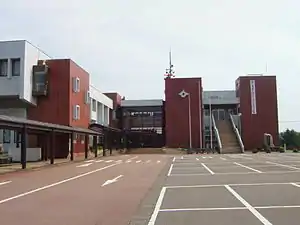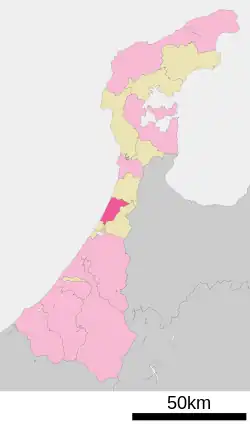Kahoku, Ishikawa
Kahoku (かほく市, Kahoku-shi) is a city located in Ishikawa Prefecture, Japan. As of 31 January 2018, the city had an estimated population of 35,188 in 12787 households, and a population density of 550 persons per km².[1] The total area of the city was 64.44 square kilometres (24.88 sq mi).
Kahoku
かほく市 | |
|---|---|
 Kahoku City Hall | |
 Flag  Seal | |
 Location of Kahoku in Ishikawa Prefecture | |
 Kahoku | |
| Coordinates: 36°43′11.3″N 136°42′24.1″E | |
| Country | Japan |
| Region | Chūbu (Hokuriku) |
| Prefecture | Ishikawa Prefecture |
| Government | |
| • - Mayor | Waichiro Aburano |
| Area | |
| • Total | 64.44 km2 (24.88 sq mi) |
| Population (January 31, 2018) | |
| • Total | 35,188 |
| • Density | 550/km2 (1,400/sq mi) |
| Time zone | UTC+9 (Japan Standard Time) |
| Phone number | 076-283-1111 |
| Address | 81 Unoke, Kahoku-shi, Ishikawa-ken 929-1195 |
| Climate | Cfa |
| Website | Official website |
| Symbols | |
| Bird | Kentish plover |
| Flower | Rosa rugosa |
| Tree | Sakura |
Geography
Kahoku is located in central Ishikawa Prefecture. It is approximately 20 km north of the capital of, Kanazawa, or thirty minutes by train. Kahoku lies between the Sea of Japan to the west, the town of Hōdatsushimizu to the north, the town of Tsubata to the east and the town of Uchinada to the south. Geographically from the east to west, Kahoku is composed of a mountainous region, a hilly region, a terrace region, a lowland region and then a coastal region. In the northern part of town the Ōmi River flows into the Sea of Japan and in the southern area, the Unoke River flows into the Kahoku Lagoon which marks the southernmost part of Kahoku.
Neighbouring municipalities
- Ishikawa Prefecture
Climate
Kahoku has a humid continental climate (Köppen Cfa) characterized by mild summers and cold winters with heavy snowfall. The average annual temperature in Kahoku is 14.1 °C. The average annual rainfall is 2500 mm with September as the wettest month. The temperatures are highest on average in August, at around 26.6 °C, and lowest in January, at around 2.9 °C.[2]
| Climate data for Kahoku (1991−2020 normals, extremes 1978−present) | |||||||||||||
|---|---|---|---|---|---|---|---|---|---|---|---|---|---|
| Month | Jan | Feb | Mar | Apr | May | Jun | Jul | Aug | Sep | Oct | Nov | Dec | Year |
| Record high °C (°F) | 19.3 (66.7) |
23.2 (73.8) |
25.0 (77.0) |
30.0 (86.0) |
31.4 (88.5) |
33.6 (92.5) |
37.7 (99.9) |
39.2 (102.6) |
36.3 (97.3) |
33.8 (92.8) |
25.9 (78.6) |
23.5 (74.3) |
39.2 (102.6) |
| Average high °C (°F) | 6.7 (44.1) |
7.2 (45.0) |
10.8 (51.4) |
16.2 (61.2) |
21.1 (70.0) |
24.4 (75.9) |
28.3 (82.9) |
30.3 (86.5) |
26.5 (79.7) |
21.3 (70.3) |
15.5 (59.9) |
9.9 (49.8) |
18.2 (64.7) |
| Daily mean °C (°F) | 3.3 (37.9) |
3.5 (38.3) |
6.4 (43.5) |
11.5 (52.7) |
16.5 (61.7) |
20.5 (68.9) |
24.7 (76.5) |
26.2 (79.2) |
22.3 (72.1) |
16.7 (62.1) |
11.0 (51.8) |
6.0 (42.8) |
14.1 (57.3) |
| Average low °C (°F) | 0.2 (32.4) |
−0.1 (31.8) |
2.0 (35.6) |
6.7 (44.1) |
12.0 (53.6) |
17.0 (62.6) |
21.6 (70.9) |
22.7 (72.9) |
18.6 (65.5) |
12.6 (54.7) |
6.9 (44.4) |
2.4 (36.3) |
10.2 (50.4) |
| Record low °C (°F) | −6.4 (20.5) |
−5.5 (22.1) |
−4.2 (24.4) |
−1.8 (28.8) |
3.3 (37.9) |
8.7 (47.7) |
13.7 (56.7) |
14.5 (58.1) |
8.6 (47.5) |
2.1 (35.8) |
−1.0 (30.2) |
−4.8 (23.4) |
−6.4 (20.5) |
| Average precipitation mm (inches) | 210.9 (8.30) |
125.8 (4.95) |
129.4 (5.09) |
121.5 (4.78) |
123.5 (4.86) |
167.5 (6.59) |
221.9 (8.74) |
186.2 (7.33) |
213.7 (8.41) |
154.9 (6.10) |
209.5 (8.25) |
252.7 (9.95) |
2,117.4 (83.36) |
| Average precipitation days (≥ 1.0 mm) | 23.9 | 18.5 | 15.9 | 12.1 | 10.5 | 10.9 | 12.9 | 9.2 | 12.5 | 13.1 | 17.2 | 23.1 | 179.8 |
| Mean monthly sunshine hours | 59.4 | 87.6 | 154.7 | 193.3 | 211.7 | 167.5 | 174.3 | 225.2 | 159.8 | 150.2 | 107.9 | 66.3 | 1,757.9 |
| Source: Japan Meteorological Agency[3][4] | |||||||||||||
Demographics
Per Japanese census data,[5] the population of Kahoku has remained steady over the past 40 years.
| Year | Pop. | ±% |
|---|---|---|
| 1970 | 32,225 | — |
| 1980 | 34,106 | +5.8% |
| 1990 | 34,207 | +0.3% |
| 2000 | 34,670 | +1.4% |
| 2010 | 34,651 | −0.1% |
| 2020 | 34,889 | +0.7% |
History
The area around Kahoku was mostly part of ancient Kaga Province, with a small portion of its northern area in Noto Province. The area became part Kaga Domain under the Edo period Tokugawa shogunate. Following the Meiji restoration, the area was organised into Kahoku District, Ishikawa. The villages of Takamatsu, Nanatsuka and Unoke were established with the creation of the modern municipalities system on April 1, 1889. Takamatsu was raised to town status on August 1, 1922, Nanatsuka on February 11, 1940 and Unoke on February 11, 1948. The three towns merged on March 1, 2004 to form the city of Kahoku.
Government
Kahoku has a mayor-council form of government with a directly elected mayor and a unicameral city legislature of 18 members.
Economy
The local economy of Kahoku is dominated by agriculture.
Education
Kahoku has six public elementary schools and three middle schools operated by the city government; however, the city does not have a high school. The Ishikawa Prefectural Nursing University is also located in Kahoku.
Junior high schools
- Unoke Junior High School
- Kahokudai Junior High School
- Takamatsu Junior High School
Elementary schools
- Unoke Elementary School
- Kanazu Elementary School
- Takamatsu Elementary School
- Ōmi Elementary school
- Nanatsuka Elementary school
- Sotohisumi Elementary school
Transportation
Highway
Local attractions
- Kamiyamada Shell Mound, a National Historic Site[7]
Notable people from Kahoku
- Kitaro Nishida, philosopher
References
- Official statistics page
- Kahoku climate data
- 観測史上1~10位の値(年間を通じての値). JMA. Retrieved March 6, 2022.
- 気象庁 / 平年値(年・月ごとの値). JMA. Retrieved March 6, 2022.
- Kahoku population statistics
- "Kahoku and its sister city Messkirch (Germany)". city.kahoku.ishikawa.jp. Kahoku. Retrieved 2020-12-10.
- 上山田貝塚 (in Japanese). Agency for Cultural Affairs.
External links
 Media related to Kahoku, Ishikawa at Wikimedia Commons
Media related to Kahoku, Ishikawa at Wikimedia Commons- Kahoku City official website (in Japanese)
- Kahoku City official website